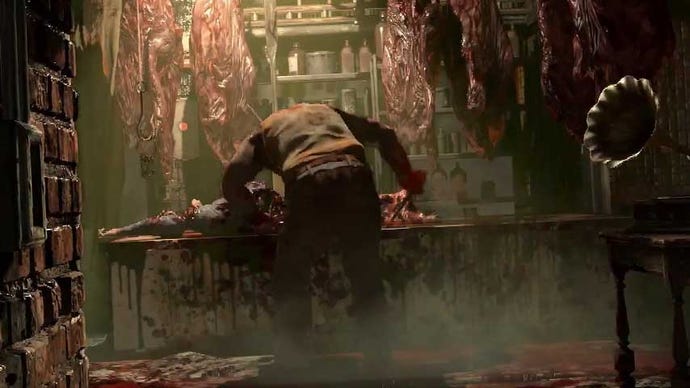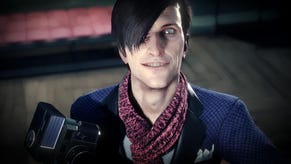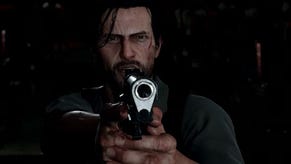The Evil Within is what Resident Evil 5 should have been
The Evil Within is a game you've waited nine years for. Brenna finds a lot for old school survival horror fans to love.
I've been thinking of the title "The Evil Within" as pointing to the darkness within the heart of man, a concept much beloved of games writers. It was only a few minutes ago, typing it next to the words "Resident Evil", that I realised the two titles could be interpreted to mean exactly the same thing: the evil that lives in something - us, a town, a mansion, and asylum.
I feel like an idiot for not having noticed this before. I don't know how meaningful it is. I guess if I thought about it at all I figured Bethesda put "evil" in the English title to create some assonance with Shinji Mikami's earlier series (I'm not equipped to judge whether the same applies to the Japanese titles, Biohazard for Resident Evil and Psychobreak for The Evil Within, but they're both double English words with little meaning to Japanese speakers and some sounds in common). But it's much more than assonance, isn't it? The title may as well just be Resident Evil.
The Evil Within is not Resident Evil, so Capcom's lawyers have to sit in a corner and grit their teeth in frustration. Claire's not in it. There's no STARS. The Umbrella Corporation is distinctly absent. The shambling, flesh-eating things you battle intermittently weren't created by a virus (I think?) and although they come back to life on the regular unless you set them on fire I have trouble thinking of them as zombies when it's barbed wire that transforms them from normal human beings into - whatever.
No, no, this is an all new IP, which is a wonderful thing, because there's only so much even the great Mikami can do with bio-engineered weapons before he starts to want to throw in vengeful ghosts, axe murderers and other delights. That, I expect, explains why Capcom went through a number of directors and weird iterations on Resident Evil 4 before Mikami had to step back to the franchise and sort it all out with the highly influential peak of the series.
With Resident Evil 4, Mikami perfected the survival horror formula he brought to mainstream attention with the series debut. Control fidelity had evolved far enough that characters no longer steered like tanks. Gunplay could be difficult and clumsy, inciting tension, without being absolute rubbish. Enemies could be made of more than polygons than found in your average play pen, and could be textured in more than a pink and grey version of bus upholstery.
Why Mikami left Capcom instead of staying to make Resident Evil 5 is shrouded in mystery and more polite discretion than, say, Keiji Inafune ever showed. Maybe he wanted to escape the triple-A grind and make small indie games. Why he came back to big budget horror is another mystery. Maybe it's the realities of the modern games industry and the pressures of keeping food on your employee's tables. Maybe he looked upon what Capcom wrought in his absence and felt a pressing need to correct it. Maybe Bethesda gave him enormous pots of money. Who knows?
The point is, he did it, and now we have The Evil Within, which is to all intents and purposes the game we wanted after Resident Evil 4.
In Matt's reaction piece, he said The Evil Within feels like a PS2-era game. That's kind of correct, in that it certainly feels like it could be a direct sequel to Mikami's last horror game, which released for GameCube in 2005. It has been said over and over again, but it bears repeating: The Evil Within is old school survival horror. It feels like Mikami picked up his tools from where he dropped them a decade ago and went right on with his work, iterating here, tweaking there, adding some new features there. If you feel it all went rapidly downhill after Resident Evil 4 and haven't found anything to fill the void, this is the game you've been waiting for.
The Evil Within is old school survival horror. It feels like Mikami picked up his tools from where he dropped them a decade ago and went right on with his work, iterating here, tweaking there, adding some new features there. If you feel it all went rapidly downhill after Resident Evil 4 and haven’t found anything to fill the void, this is the game you’ve been waiting for.
Some fans will have found something to fill the void, and they may not be tempted back. Last time I wrote about the comeback of old school survival horror I mentioned my dissatisfaction with our industry's embrace of "more of the same", even while acknowledging the fact that fans have been starving for these experiences.
The Evil Within has scored big with reviewers - mostly. The positive voices sang its praises, citing its faithfulness to a genre we rarely see implemented well any more now that the Fatal Frame, Silent Hill and Resident Evil glory years are behind us. The negative voices grumbled about its constraints and lack of modern gloss.
When I say gloss I don't mean graphically, although it's not the prettiest game I've ever seen (and the widescreen aspect ratio drives me nuts). I mean that sheen of ease and accessibility of recent triple-A: the way Call of Duty games play themselves, and difficulty adjusts downwards, and the tension of potential failure is replaced by the excitement of constant explosions. That slick, frictionless experience.
Resident Evil 5 - sorry, The Evil Within - doesn't have that. Instead, it has that awkward, difficult gunplay; unforgiving inventory management, and non-regenerating health that has you sweating on every encounter, well aware that a mistake will come back to haunt you sooner rather than later. In our nostalgia, we miss that, but I must admit in these time-poor adult days of stressing about my tax bill and house lease deadlines I personally would prefer something a little more brainless and less likely to send my blood pressure so high my doctor stops threatening and actually locks me up in hospital.
To reiterate, if you've been gagging for resident Evil 4-2, then here it is, and that's great for you. For me personally, I've moved on from survival horror and onto horror simulation.
This is a division I picked up recently from Thomas Grip, creative director of Amnesia: The Dark Descent developer Frictional Games. Grip keeps a thoughtful, informative blog about his own games as well as others, and his latest entry, a discussion of Alien: Isolation, is a great read.
Grip makes a distinction between two kinds of horror game: games that attempt to simulate the experience of horror, and games of various genres with a horror "wrapping". In the former category you find games like Clockwork Tower and Amnesia, and in the latter you find The 7th Guest, Resident Evil and The Evil Within.
This is not to disparage the second category, into which survival horror falls, in any way. There's nothing stopping them being spectacularly scary (and very good games). But for me, the experience of playing a survival horror game - the resource management, the reliance on combat as a last but always necessary resort - doesn't hold a candle to games that put you right there, heart beating in terror alongside the playable character's, with as little hope to destroy or survive the encroaching darkness.
When I play The Evil Within, Resident Evil or Silent Hill, I get very scared (and I'll hear no lip about it). But I always know it's a game. I always know the shotgun's there in my back pocket - and if it isn't, well, there's a checkpoint or a save file not that far back, and dying isn't so bad. It just gives me a chance to do better: aim more smoothly, navigate more carefully, scan the environment more closely. I may scream (or more likely, break into a sweat and crawl up the couch back with my shoulder blades, as when I'm sneaking around that horrid cleaver man in The Evil Within), but I always know I'm playing a game. (Related: since I started playing 3D action adventure games in the PSOne era, I have developed lucid dreaming. When I have a nightmare, I pull out a shotgun. This is quite common for gamers, apparently.)
Meanwhile, so-called "walking simulator" P.T. had me shutting down my console, turning all the lights on, and literally crying - before switching back on, desperate to find out what was going on and what to do next. In survival horror, you have so much agency, but it never feels immediate the way P.T. and Alien: Isolation do. You step cautiously, and open doors slowly, ears straining for every sound. You behave much as you would in real life if weird as f**k s**t started going down around you; you are in fear for your life.
That, for me, is the difference between survival horror and horror simulation. In The Evil Within, I'm never in fear of my life, because I'm always aware that I have another one; it's just a game, and a game I can win - even when it terrifies me.
Survival horror and horror simulation both have their advantages and disadvantages, fans and detractors. I'm delighted that in the year 2014, after years of silence from one of my favourite themes, we suddenly have room again for both kinds of horror in the triple-A space.













